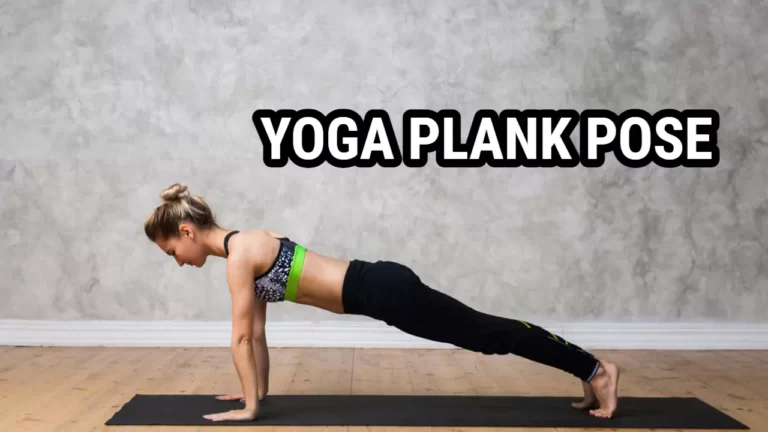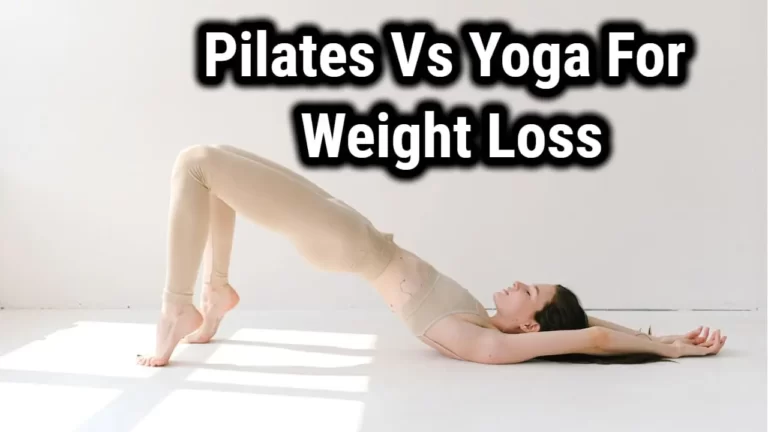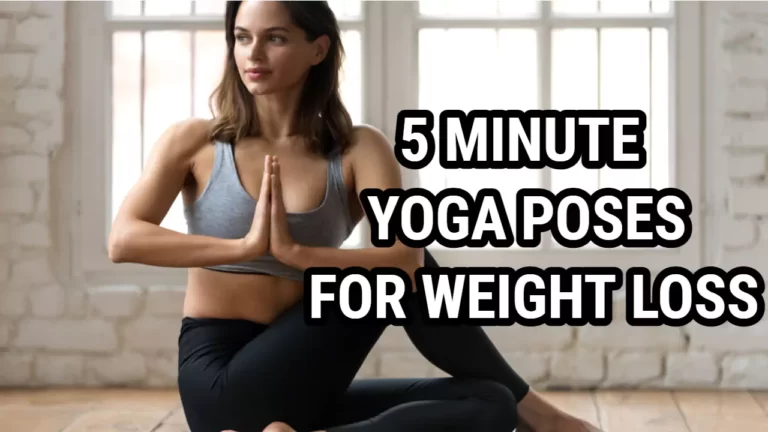Can You Lose Weight Doing Aerial Yoga?

Are you looking for an exciting and unique way to lose weight? Aerial yoga could be the perfect solution! This special type of yoga combines traditional poses with aerial movement, creating an intense workout that can help you shed those extra pounds.
Here we’ll look at what aerial yoga is, how it works, and answer the question: Can you really lose weight doing aerial yoga?
Aerial yoga is a relatively new form of exercise, but it’s quickly gaining popularity. It’s a combination of traditional yoga poses and acrobatics that uses a hammock or swing-like structure suspended from the ceiling.
The structure gives you the freedom to move in ways that may not be possible on the ground, as well as providing support for more challenging poses. And because aerial yoga requires so much balance and control, it’s often considered to be a full-body workout.
So, can you really lose weight doing aerial yoga? The answer is yes – although it won’t happen overnight! As with any exercise regimen, consistency is key when it comes to seeing results.
With regular practice and dedication to your goals, aerial yoga can provide an effective way to burn calories and build strength – leading to long-term weight loss success.
Definition Of Aerial Yoga
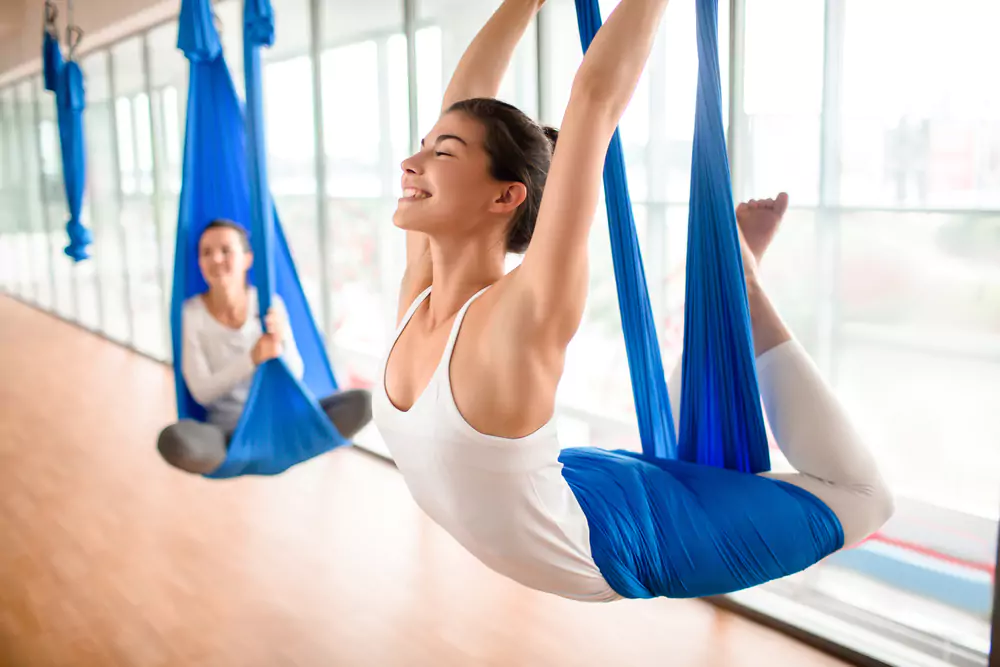
Have you ever wondered what aerial yoga is? Aerial yoga, also known as antigravity yoga, is an innovative form of exercise where participants practice traditional yoga poses while suspended in a hammock. The hammock acts as a support system that allows practitioners to stretch and deepen their poses while taking pressure off the joints.
So, how can aerial yoga help with weight-loss?
Aerial yoga combines elements of traditional yoga, acrobatics, and dance to create an energizing and effective workout. It helps improve strength, flexibility, balance, coordination and core stability. In addition to strengthening muscles and improving overall health and wellness, aerial yoga can be an effective way to lose weight.
Studies have shown that aerobics increase metabolic rates significantly more than other forms of exercise such as walking or jogging – leading to increased fat burning potential during the session.
By combining aerial exercises with dynamic postures from traditional yoga styles like Vinyasa or Hatha Yoga, practitioners can achieve great results in terms of weight loss.
Benefits Of Aerial Yoga
Aerial yoga is not only a fun and exciting activity, but it also offers many health benefits. With regular practice, aerial yoga can help improve flexibility, posture, balance, and even provide stress relief. Here are some of the key benefits of aerial yoga:
Increased Flexibility: Aerial yoga involves stretching and strengthening exercises that utilize the support of fabric hammocks to assist with postures. This helps to deepen stretches while reducing the risk of strain or injury. Additionally, the hammock enables more intense poses that might otherwise be inaccessible on a traditional mat. This allows for increased flexibility in areas such as hips, hamstrings, and shoulders.
Improved Posture: Poor posture can lead to aches and pains throughout your body. However, because aerial yoga requires you to maintain an upright posture throughout each pose, it helps strengthen your core muscles which can improve your overall posture when practiced regularly.
Stress Relief: In addition to physical benefits, aerial yoga can also be beneficial for mental health by providing stress relief. The combination of deep stretching and breathwork in each pose can help reduce stress levels and promote relaxation. Additionally, being suspended in mid-air gives practitioners a sense of freedom and weightlessness that can be calming for the mind.
The regular practice of aerial yoga has been shown to bring about improved flexibility, improved posture, reduced stress levels and improved balance – all while having fun. Whether you’re looking to increase your strength or just destress after a long day at work, aerial yoga may be just what you need!
Potential Risks Or Disadvantages
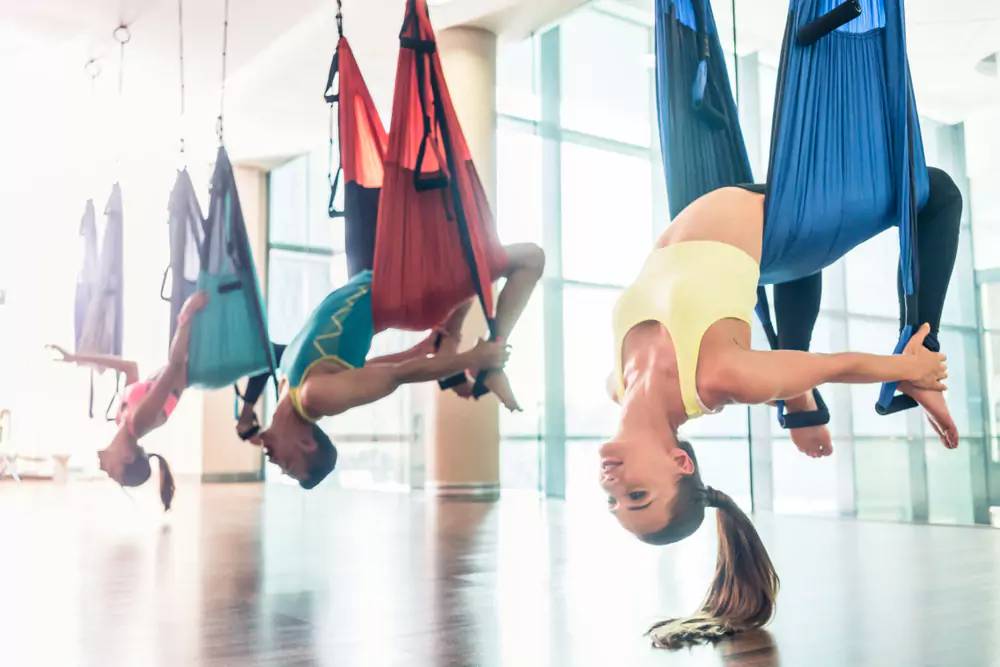
Aerial yoga does have some potential risks or disadvantages that one should be aware of before participating. It is important to remember that since aerial yoga involves hanging upside down, there may be an increased risk of injury.
Additionally, the body weight-bearing poses involved in aerial yoga can cause muscle strain and the inversion of the body can lead to circulation problems. Furthermore, vertigo or dizziness may occur due to the upside-down position.
Here are a few key points to consider when it comes to potential risks:
- Injury risk
- Muscle strain
- Circulation problems
- Vertigo/dizziness risk
It is important for those considering taking up aerial yoga to be aware of these potential risks and consult with their physician if they have any concerns before engaging in this activity.
Furthermore, it is essential for participants to ensure that their instructor has adequate training and experience in teaching aerial yoga, as well as having a thorough understanding of the safety guidelines associated with this type of exercise.
With proper instruction and caution, individuals can enjoy the benefits of aerial yoga without putting themselves at excessive risk.
Calories Burned During Aerial Yoga
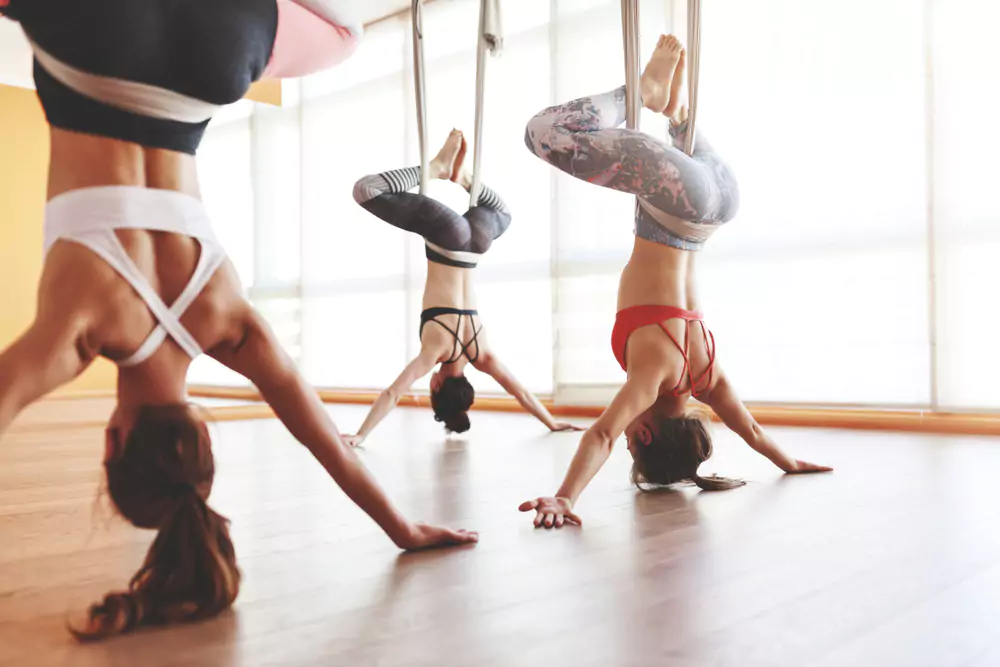
Aerial yoga is a great way to get fit and lose weight. During an aerial yoga class, you use your own bodyweight, gravity, and the fabric hammock to create resistance, allowing you to work your muscles in ways that can’t be done on the ground. But just how many calories can you burn during an aerial yoga session?
Calorie burn depends on the type of aerial yoga poses you do and how hard you work. During a typical 60-minute session, people can expect to burn anywhere from 400-600 calories.
This means that if you incorporate aerials into your regular fitness routine, it could help with weight loss goals. Additionally, aerial yoga also helps improve flexibility and posture which leads to better overall health.
To maximize calorie burning during a aerial yoga session, focus on more challenging poses such as inversions and arm balances. Also, aim for longer holds when possible – this will help increase intensity and help burn more calories.
Therefore, aerial yoga is an excellent way to get fit while having fun. When practiced regularly it can lead to increased strength and flexibility while helping achieve weight loss goals too!
The Role Of Diet In Weight Loss
It’s not enough to just do aerial yoga if you want to lose weight. Diet plays a significant role in any weight loss program, and aerial yoga is no exception. To maximize the effects of aerial yoga, it’s important to understand the role of diet when it comes to weight loss.
First and foremost, it’s essential to reduce your caloric intake while also ensuring you’re getting adequate nutrition. A healthy diet should consist of lean proteins, fruits, vegetables, healthy fats, and whole grains. It’s also recommended that you limit or avoid processed foods and sugary drinks as much as possible.
Here are a few diet considerations for success with aerial yoga:
- Prioritize Eating Whole Foods: Choose fresh produce over packaged snacks whenever possible.
- Increase Protein Intake: Make sure you’re getting enough lean protein sources such as nuts and legumes throughout the day.
- Limit Sugar Consumption: Cut back on added sugars from food and beverages to maintain energy levels throughout the day.
- Hydrate Adequately: Drink plenty of water before and after each session for optimal performance and recovery.
By following these simple dietary guidelines, you can ensure that your efforts doing aerial yoga will be supported by a healthy diet that helps facilitate weight loss. With dedication and consistency, combining aerial yoga with a balanced diet can help you reach your health goals.
Also Read: How To Lose Weight From Lower Body With Yoga
Exercise Frequency And Intensity
Exercise frequency and intensity are important factors to consider when thinking about losing weight with aerial yoga.
To achieve the best results, it is recommended to do aerial yoga at least three times a week, although more frequent sessions can be beneficial. In terms of intensity, there are different levels available for aerial yoga depending on the individual’s skill and comfort level.
Each participant should strive to challenge themselves within their own abilities in order to maximize the aerobic benefits that come with this type of exercise.
When increasing the frequency or intensity of any type of exercise, it is important to remember that taking breaks and listening to your body is key. Doing too much too soon can cause overuse injuries or make you feel burned out.
It is better to start slowly and gradually increase both your frequency and intensity as you gain strength and endurance. Make sure to give yourself enough time between workouts so you don’t become overly fatigued or stressed out by your routine.
Finding the right balance between frequency and intensity when doing aerial yoga is essential for achieving weight loss goals in a safe manner. Listen to your body and adjust accordingly in order for you to reach your desired results without putting yourself at risk of injury or burnout.
Finding The Right Instructor
When looking for the right aerial yoga instructor, it’s important to research their credentials and experience. Most instructors will have an online presence, making it easy to learn more about them and their background.
Look for someone with certifications or qualifications that demonstrate they are experienced in teaching aerial yoga classes. Additionally, read reviews from past students to get a better idea of what kind of instructor they are.
Finding an aerial yoga instructor who is a good fit can help make your practice more enjoyable. Consider what type of class you’re looking for and whether the instructor offers the kind of classes you want to take.
Once you find one or two instructors that seem like a good fit, reach out directly to get more information on their class offerings and styles.
When selecting the right instructor, don’t forget to factor in cost as well as location. While many studios offer discounted rates for first-time students or those who sign up for multiple classes, others may charge higher prices for private lessons or specialized workshops.
After you’ve narrowed down your options, be sure to ask questions about any additional fees that may be associated with attending their yoga classes.
Equipment Considerations
Now that you have found the right instructor, it’s time to think about the equipment you’ll need for your aerial yoga practice.
The primary piece of equipment used in aerial yoga is a hammock. This usually consists of two long pieces of nylon fabric that are connected to a sturdy frame or ceiling mount.
You will also need an aerial yoga silks (also called a yoga trapeze) and a yoga swing. These items can be purchased from most sporting goods stores or online retailers.
Before buying any equipment, make sure you check the quality and safety standards. You should also read customer reviews to see how satisfied others are with their purchase.
It’s important that the material is strong enough to hold your weight and won’t rip or tear during use. Check for any signs of wear and tear, such as fraying, stains, or loose stitching on the fabric or frame before making a purchase.
When shopping for aerial yoga apparatus, look for features such as adjustable height settings so you can find the best fit for your practice session. You might also want to consider purchasing additional accessories like leg loops and handles which can help make your practice more comfortable and enjoyable.
Guidelines For Safe Practice
When practicing aerial yoga, safety should always be the top priority. To ensure a safe practice, there are several guidelines every practitioner should follow:
- Always use a certified instructor – even if you are experienced in yoga and other physical activities, aerial yoga is different and has its own set of safety rules to follow. An instructor will help guide you through the poses and make sure you’re doing them correctly.
- Consult your doctor – before beginning any kind of physical activity, it is important to check with your doctor first to make sure you are healthy enough for aerial yoga.
- Prepare the body beforehand – stretching or taking an active restorative class prior to your aerial yoga practice can help prevent injuries due to overworking certain muscles or joints.
- Listen to your body – pay attention to how your body feels during practice and don’t push yourself too hard; if something doesn’t feel right, stop immediately and consult a professional if necessary.
It is also important to take note of the environment in which you are practicing; making sure that all equipment is properly installed and secure, that mats are placed on the floor beneath the hammock for added cushioning and support, and that the space is free from hazards like furniture or sharp objects that could cause injury if collided with during practice.
By following these guidelines for safe practice and listening closely to your body’s needs, you can benefit from an enjoyable experience with aerial yoga without risking injury.
Related Read: Yoga vs Zumba: Which is the More Effective Workout
Conclusion
Aerial yoga is a great way to get in shape and lose weight. It’s an engaging and fun way to mix up your workout routine and has numerous physical benefits. With that said, it’s important to find the right instructor, use the proper equipment, and follow safety guidelines for safe practice.
As with any exercise program, dedication and consistency are key when it comes to losing weight with aerial yoga; Rome wasn’t built in a day! With patience and perseverance you’ll be soaring through your workouts in no time – just don’t forget to enjoy the ride.

